Trending
Opinion: How will Project 2025 impact game developers?
The Heritage Foundation's manifesto for the possible next administration could do great harm to many, including large portions of the game development community.

Featured Blog | This community-written post highlights the best of what the game industry has to offer. Read more like it on the Game Developer Blogs or learn how to Submit Your Own Blog Post
In narrative-driven games, how much of the story informs the gameplay? How much of your writing translates into mechanics and interfaces? The makers of Pathologic 2 reinvent questlogs and codexes so that all aspects of your game are relevant to the story.

This article was originally published on Game World Observer on August 12, 2019.
Pathologic 2 developed by Ice-Pick Lodge is an open-world survival thriller set in a town that’s being consumed by a deadly plague. Its cheerful tagline “You can’t save everyone” pretty much says it all.
The game came out on May 23, 2019 to critical acclaim and very positive reviews on Steam.
In June 2019, Alexandra “Alphyna” Golubeva, the then narrative designer at Ice-Pick Lodge, spoke at gamedev.world on how the studio reinvented questlogs and game codexes.
What follows below is a transcript of Alplyna’s report gently edited for clarity.
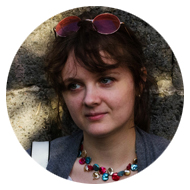
Alexandra “Alphyna” Golubeva
My name is Alphyna. I work as a narrative designer at Ice-Pick Lodge [not anymore! Alexandra currently holds the same position at Wargaming — Ed.] and today I would like to tell you about how we implemented the mechanic of the so-called “mindmap” in our game Pathologic 2 [The title is a spiritual successor to Pathologic (2005) from the same studio. — Ed.].
My responsibility as a narrative designer is to make sure that there’s consistency across all aspects of our game. I also deal with its general dramaturgy and story delivery. Just to be clear: I am not going to talk about how we came up with our story. Instead I’ll try to tell how we came up with ways to convey that story to the player.
Let me first explain what Pathologic actually is. It is a survival game where you can fight, trade with children for blades and needles, and die from hunger. Again, details of the story are not very important because we are only going to discuss the game’s narrative design.
And as far as the game’s narrative design is concerned, here’s what’s important:
The game is open-world, which implies freedom for the player.
The story unfolds in real time, which implies even greater freedom for the player because they can simply choose to do nothing on time. An event can end and the player will miss it. It sounds very cool, of course, these levels of freedom, but writers and narrative designers die inside a little bit every time it happens;
There are many characters in this game, many events scattered all over the map. It’s like the Witcher riding the Last Express into the magical world of Banner Saga.
And boy, does this game have lots of text. Haruspex’s story alone in Pathologic 2 counts 250 000 words. That’s equivalent of two volumes from “War and Peace,” or 3.5 “Blood, Sweat, and Pixels.” It means it’s a game for people who like reading. Obviously. But it also means that we must be very careful with the player’s attention. If people are going to read such a colossus, we should not waste their attention on any unnecessary words because there are just too damn many of them as it is.
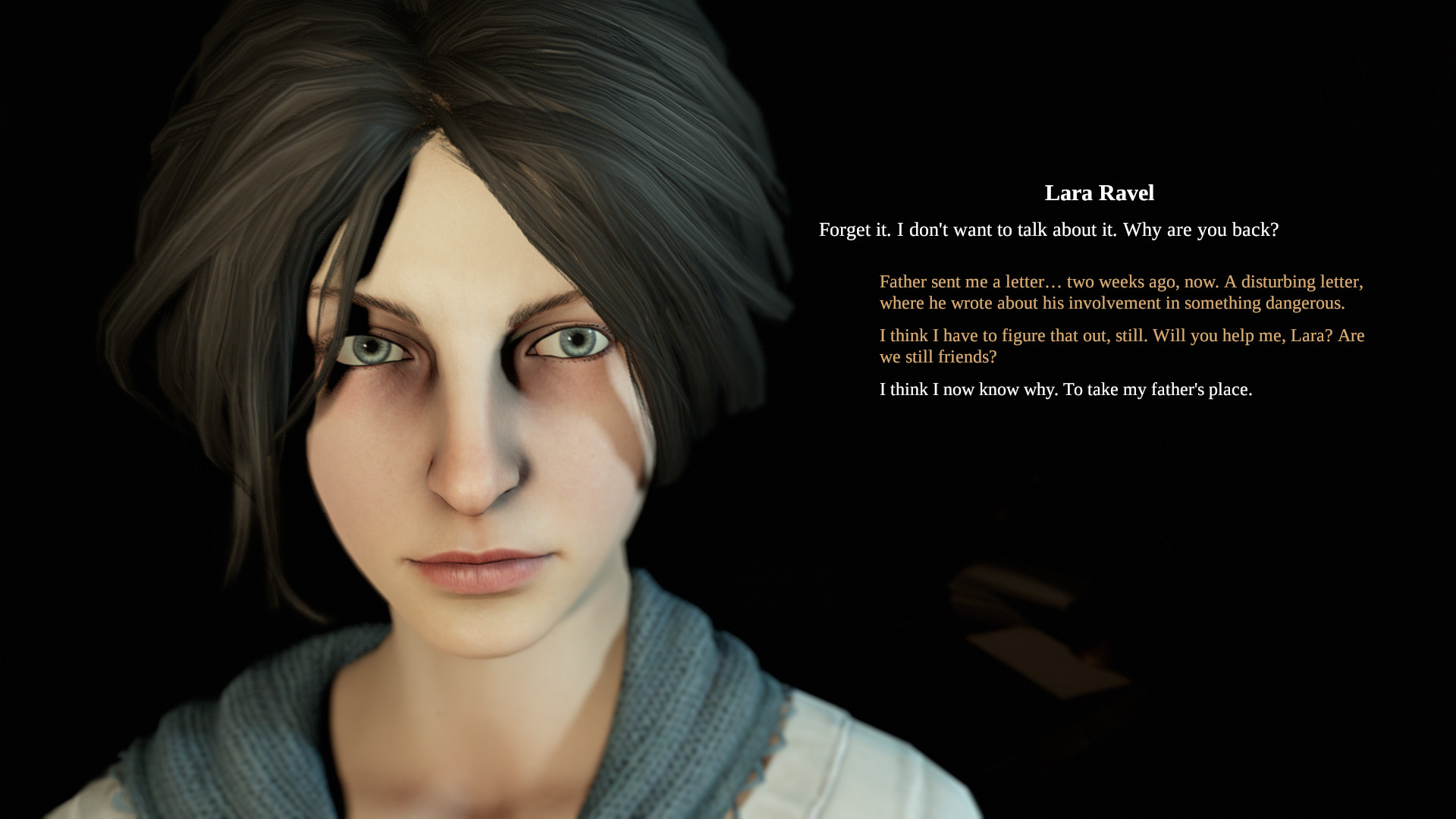
Dialogue screen
This is what the dialogue screen looks like. Here, nothing distracts the player from the text. You only see the character, their lines, your lines. You can’t exit this screen anyway, you are doomed to read it through to the end. You simply have no other choice.
But when we proceed to the questlog screen, we find ourselves in a rather unfortunate situation…
You see, reading our dialogues is like sitting in a chair in front of a fireplace, with a smoking pipe in one hand a book by Lovecraft in another.
And then there is the questlog and all sorts of other technical texts in the game. Reading them is like taking that Lovecraft book and coming to a techno party, where all the “OONTZ OONTZ OONTZ” is happening with the crowd raving around you in the dark.
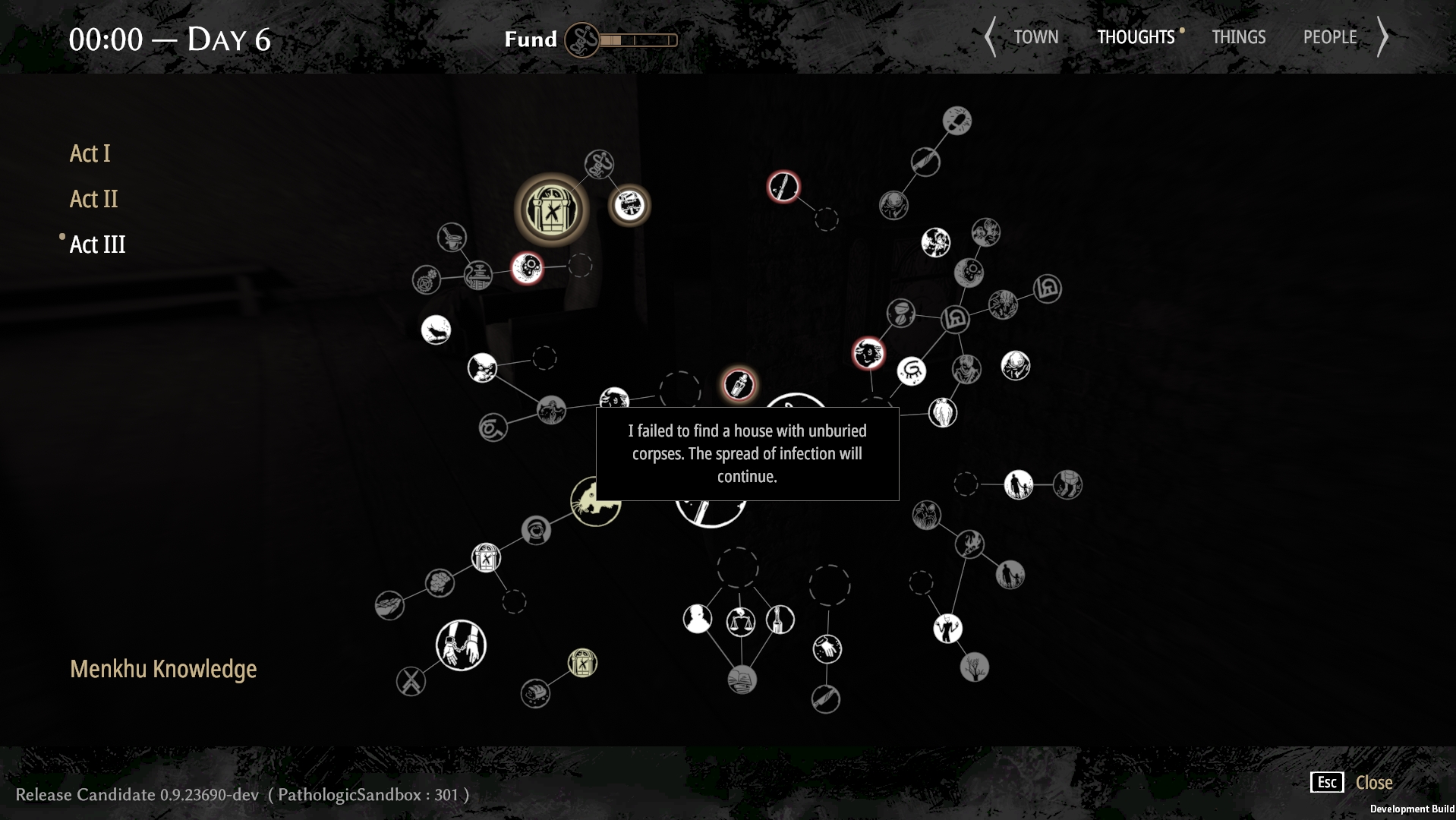
Things get more complicated with the questlog
It is much harder for players to focus on the text outside the dialogue screen.
So, our task as developers is to help them somehow.
And we thought: the story is complex, it’s difficult to navigate and keep track of… Let’s pretend it’s a feature!
We had creative tasks that are unique to Pathologic, so it’s unlikely that they will concern your game. However, we also had tasks that we solved that other developers may very well be struggling with. So I hope you will be able to learn from our experience.
So, very briefly, what we wanted to do with Pathologic. The game’s protagonist is a “weaver” connecting that which was torn. It is the philosophical concept underlying the entirety of our game.
Our protagonist walks the open world, interacting with different characters, thus drawing connections between them. People who did not know of each other’s existence will learn about each other. In a way, the protagonist collects what was scattered. And we wanted our questlog to somehow show this, to mirror the theme of the game.
And we also had another ambitious task. We really wanted the interface to emulate the protagonist’s thinking, their inner world.
But there were also all sorts of practical tasks that we solved that are more down-to-earth.
Make the complexity of the plot a feature instead of a hindrance. We have a very complicated story. See how many lines there are? And let’s make it a good thing, not a disadvantage that just buries the player with information and messes with their perception.
Retain the characters’ characters.
Have a little less text and a little more visual presentation for those things that are best conveyed visually.
Get rid of the idea of “main” and “side” quests. This task may not be relevant for every game. But we really wanted to make sure that the main quests and side quests do not fall into completely separate categories. I really wanted the game events to feel like they are part of the same canvas.
Replace goals with ideas. More on that later.
Find a place for technical texts. This task was my personal pet obsession. I really wanted the ancillary texts in the game to not be a separate thing. You know how sometimes in a game you have a codex with some lofty literary text, and then right next to it, there is a line that says “Go kill 10 rats?” Who wrote this? Is it the protagonist talking to themselves like that? Is it God talking to them? What is the nature of this text? So we wanted to somehow integrate these technical texts that any game needs into the narrative.
Help the player who abandoned the game for a time get back into it. Finally, the task I think many developers feel very strongly about. We are all grownups, we have day jobs and maybe sometimes on Sunday evenings we come home and play the game. We start it and we hardly remember anything that happened in the game last Sunday. How do we as developers help players remember what happened in the story earlier?
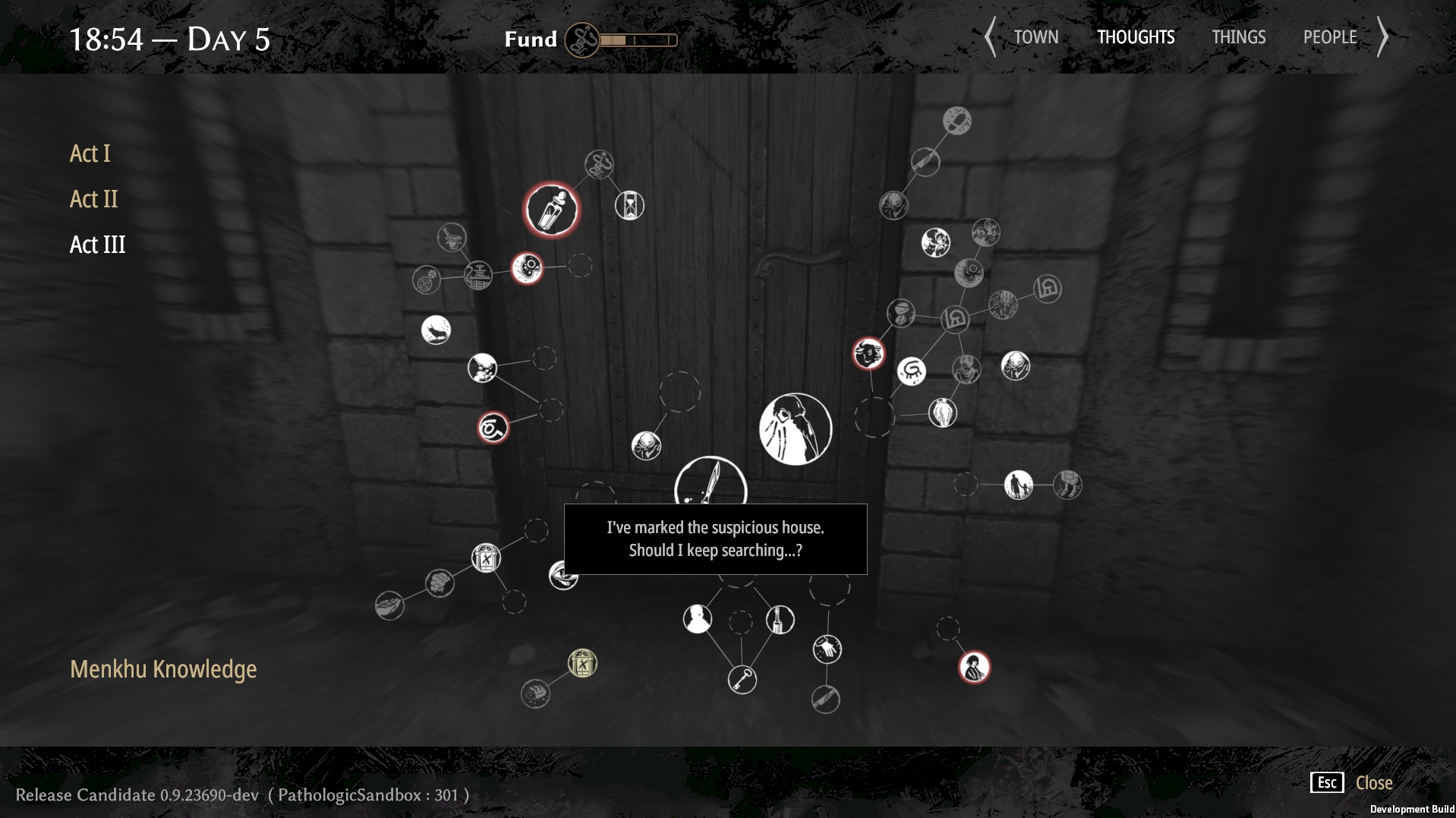
I think those involved in management or structuring of anything (not just plots) are familiar with the concept of a mindmap. It’s a tool that allows you to organize information around a central idea.
Our mindmap is made up of circles that we call nodes. Each of them symbolizes a thought. They can appear in a variety of ways, through different types of interaction with the game world. Through dialogues, fights, reading object descriptions. They can appear the moment you picked up an object or when you waited for some time, when you passed by a building. All of these are very miscellaneous things, but each one of them can give you thought. And all thoughts are encapsulated in identical circles, so they look like something categorically homogeneous.
I think what this does is stop players from sticking to any single pattern of interaction with the game world. Because anything at all can give you a thought. The plot is everywhere.
The mindmap is the voice of the protagonist, it shows their thoughts, their character. If you play the game, you will notice how the wording of the nodes is unique to a character: it’s not all just the statement of facts, the protagonist also expresses some attitude towards them and in doing so reveals their personality.
Mindmap also intertwines stories with each other. You can just see with your eyes that the big pieces of the mindmap are all interconnected, with side stories confined to the periphery.
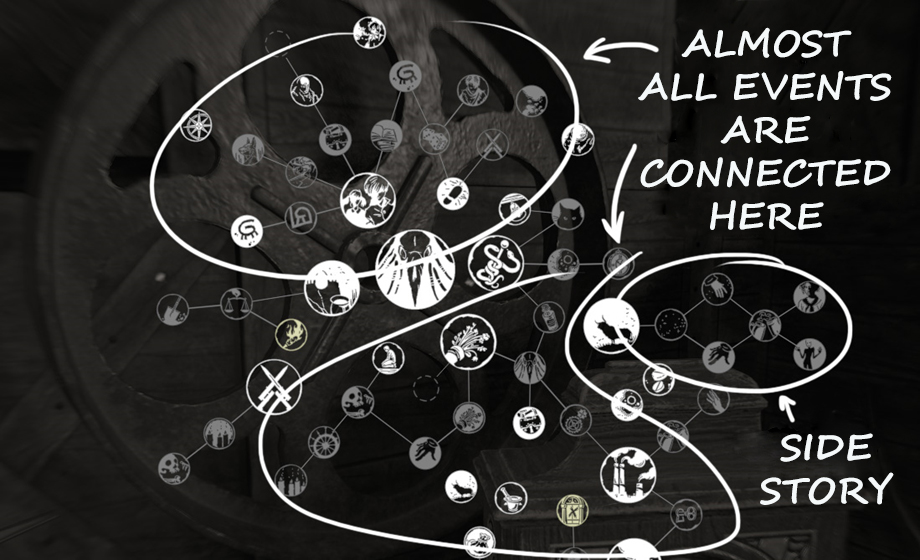
Among other things, this is a good self-check for writers, from my point of view. You don’t even have to implement this system in your game. Just sit down and make a drawing of your story in the form of some kind of mind map. If it consists of many separate pieces, maybe your story is not coherent enough, maybe you should think how to make your storylines more connected.
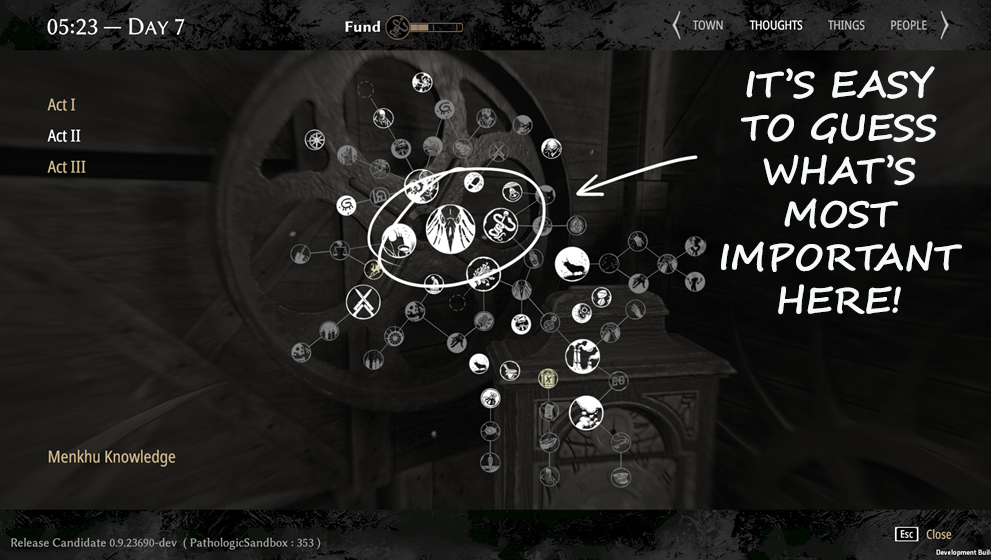
The mindmap visually informs us what is more important and what is less important here, what happened earlier and what happened later. The mindmap is assembled concentrically from the edges to the middle. And visually it is clear that what is around the edges happened a long ago and is probably less important than the big, bright stuff in the middle.
The connections between nodes do not necessarily represent connections between events. Sometimes a node is just an abstract thought that the protagonist inferred.
And these thoughts can connect side stories with the main one because thoughts that the protagonist takes out of a side story may be relevant for the main one.
For example. And this is not a spoiler. Suppose there is a story on the first day about how people beat up a guy because of mistaking him for you. You can help him beat the attackers. Or not. In a more traditional questlog, this would cause a line to appear: “I helped the dude who was mistaken for me, I did not let him take a beating.” Or vice versa.
In Pathologic, an event like this would result in a node that would read: “In this town, they do not really understand who is who, and in general, are not very careful about people’s identities.” And this node now lingers on the mindmap and, for example, on the third day, it can provide a clue for the player. That they can pass some kind of quest posing as another person. See how it’s all interwoven?
Our mindmap is integrated with the game map. Some thoughts have this red glare around them. That means they are also markers on the map. If you click on them, the map opens with nodes assigned to different places. And vice versa. If you open the game map and click on the marker, a corresponding piece of the mindmap will unfold.
What’s so cool about that? It’s cool because it allows you to write anything on markers.
If we look at the games that are similar to Pathologic – not content-wise, but structurally – we will see that quests are usually formulated imperatively. I mentioned this a little earlier. “Go there to kill ten rats.” Who said this? Who wrote it on the map? Is the protagonist some kind of middle manager, who uses JIRA to assign themselves tasks like this? Or it is some kind of deity that sets tasks for them in JIRA?

The Witcher 3. A quest is imperative. Who is saying this?
In Pathologic, we have no orders for quests. We have thoughts, which feels much more organic.
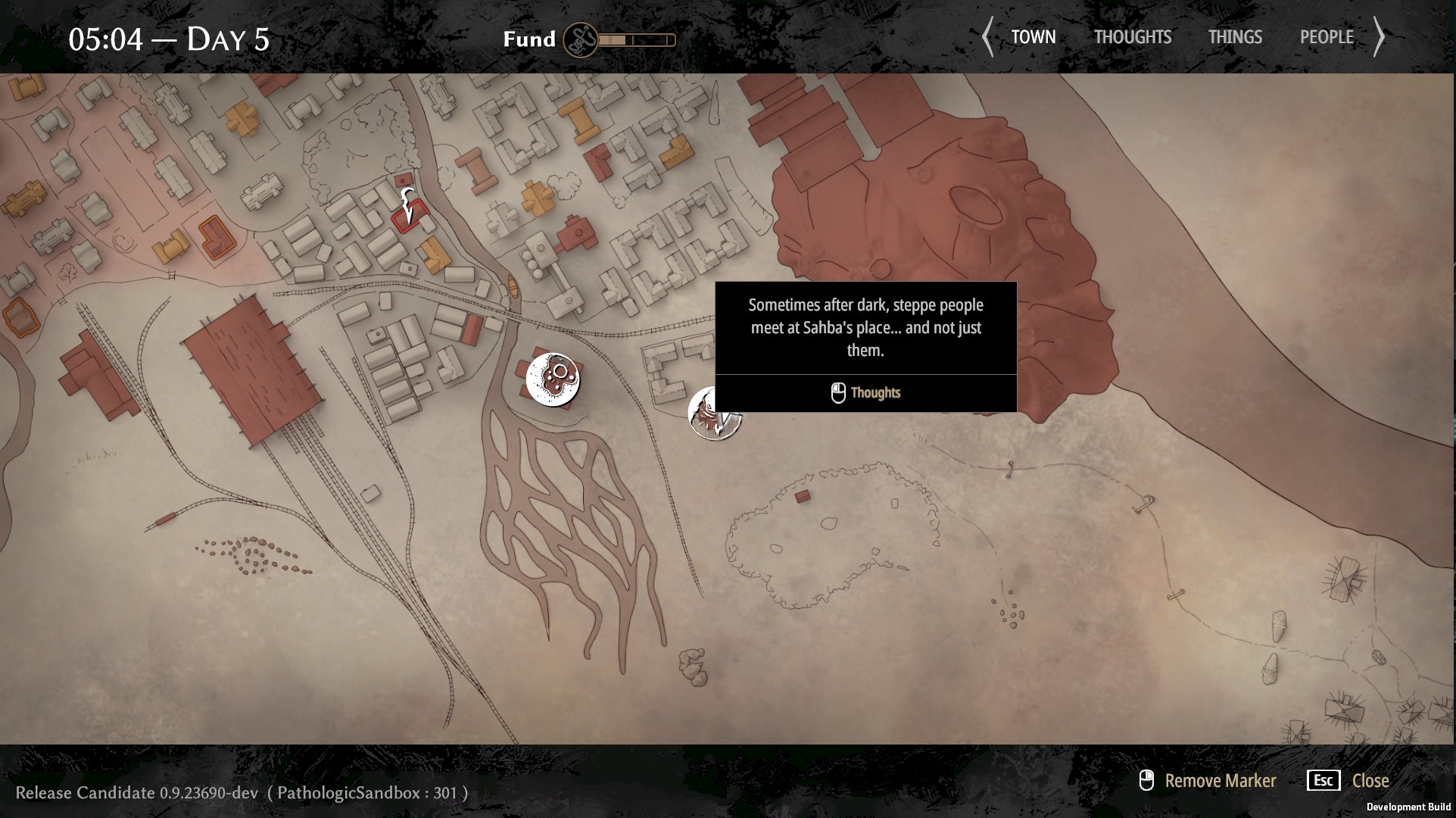
Map integration allows for freedom with wording
Mindmap also combines and intertwines different kinds of information. There are some philosophical reflections of our protagonist. There are some experiences, there is lore, background information about the world. There are specific facts like “I gave my enemy a black eye”. There are specific instructions on where you need to go and what to do there. It even has tutorial information. And that’s the thing. Even tutorial information becomes more interesting and adds something to the story when it is included in this big picture.
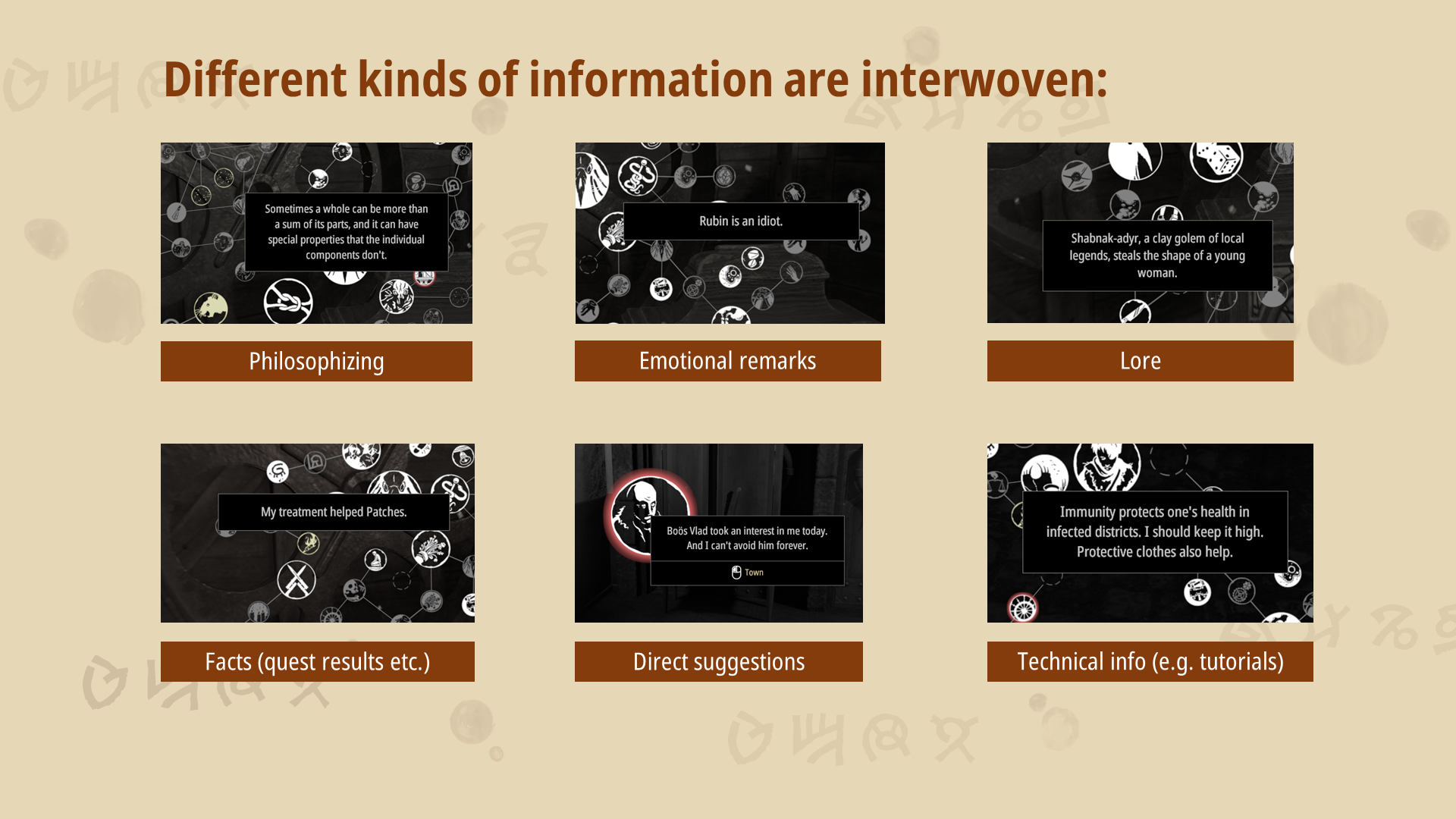
Quest markers, pointers, tutorials, and all this technical stuff is often uninteresting in games. So we try to make it more interesting by weaving it into the overall picture of events.
The same holds true for the codex and the information about the world, which is often uninteresting for the opposite reason: because it is too detached from events, making the codex some kind of bonus addendum that is simply thrown in the game for good measure. Again, we are trying to weave it all together.
Moreover, when I play games with an open world, like The Witcher, I have this problem. I take twenty quests and I’m not going to the one that is more interesting to me right now, I’m going to the one that is closer to me on the map. I come there and I don’t remember who the hell gave me this quest, what we talked about. There must have been some dramatic story to this. Of course, thanks to the imperative wording, I can figure out that I just have to kill ten werewolves, but I don’t remember why. If The Witcher had a mindmap like ours, I would click on the marker and see the adjacent nodes, and the context would pop up in my head. The game would immediately remind me who it was I was talking to and why I had to take care of these werewolves.
The mindmap chronicles the events that happened in the game. If you closed the game, forgot about it and went on to play something fun, not Pathologic, then when you do come back to it, it will be a little bit easier for you to remember what was happening in the game.
Now the coolest thing evah! Remember how we wanted to make the complexity of our plot a feature?
The mindmap in our game is updated every few in-game days, that is, every few story beats. Some events happen, they lead to a certain point. And once this point has been reached, the pages of the mindmap turn over. A new blank page appears. And previous pages are conveniently stored under Act 1, 2, 3, and so on, as shown on the slide.
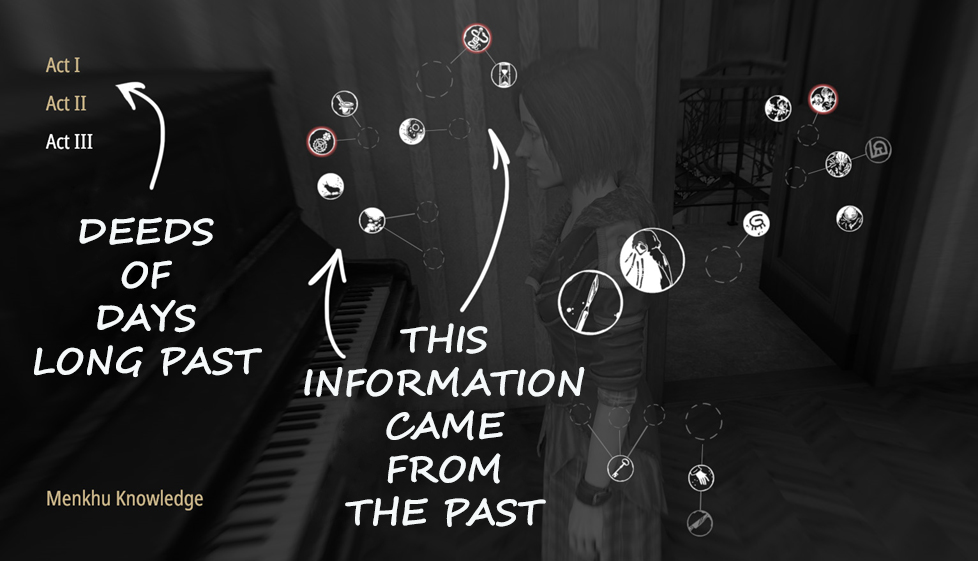
The mindmap captures the current state of character’s mind
Thanks to this, all information that is relevant to the player is compiled on a single page. Think about it. We have a structurally complex plot. Not only do we not attempt to simplify it, we actually emphasize that it is structurally complex – and at the same time, it is all easily available with just one click.
How cool is that? Presenting complex information in a form that is accessible and easy to interact with. That’s the way all systems should be ideally.
And we know from the player feedback that people really enjoy the feeling of gradually filling the picture of the world. How it’s first empty, but then you are gradually moving towards this truth, towards the center. Connections and associations are beginning to form, So this becomes a mini-game in and of itself that rewards the player with a sense of progress and achievement, even if all they have achieved is that everyone died from plague.
I actually made a little GIF for you. As you progress through the game, you typically see new events resulting in new nodes. See how cool it feels to be gradually filling the empty space?
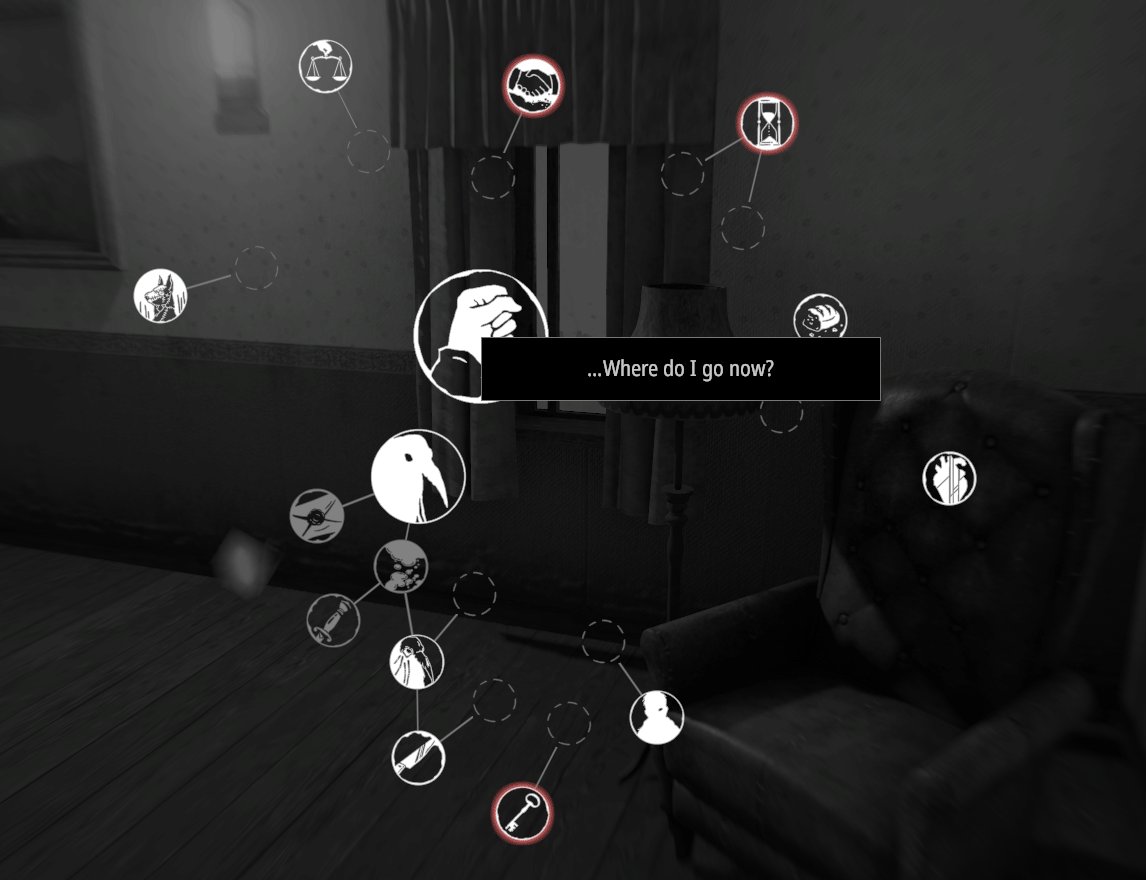
One problem we had with our mindmap is figuring out how many quests should be allowed to appear on it?
As information piled up, too many nodes appeared on the screen, cluttering it. We wanted to avoid that. So instead of always packing a certain progression into a chain of circles, we decided we would sometimes update the same circle several times. In the GIF above you can see the central node refresh periodically.
Should all quests appear on the mind map? No.
Pathologic has small events that we don’t put on the mind map to avoid information overload. As I said, you have to be very careful with the player’s attention. So if there is some small event that exists just to make the world look more alive but does not tune into some of the main themes of the game, we don’t put it on the mind map.
To be fair, that’s where one of the game’s weaknesses lies: excessive notification. This thing is updated frequently. On the one hand, it’s nice because you have a feeling of acknowledgment every time you find something, some new content. On the other hand, during playtests I saw people growing weary as the new nodes just come too often. We fixed it in some specific situations, but I think the system itself could have been calibrated globally a little better.
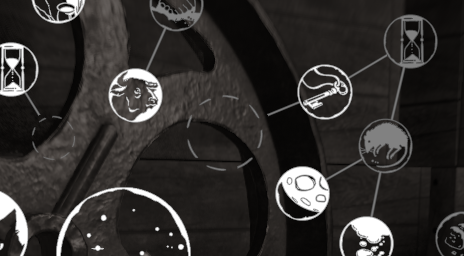
As you can see, we have dashed lines. When some consequence should transpire as a result of some event over time, we give players a hint by drawing a dashed future node. But at the same time, we do not reveal how many such nodes are ahead. Well, sometimes you can guess, but here is a screenshot of the situation where it is unclear how many nodes are to follow.
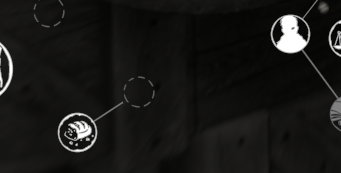
So the player understands that this event will lead to something, but what exactly it will be they don’t know.
Doesn’t it spoil the plot though? After all, it allows the player to see how many plot development options are possible.
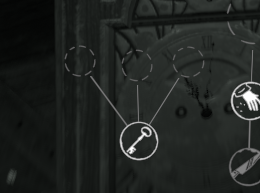
Gee, I wonder how many outcomes this quest has?
Or sometimes the mindmap shows you that two nodes both lead to the same dashed circle hinting at the fact that these plots will intersect. So doesn’t it give away some of your clever twists in the story?
Well…
First of all, spoilers can be a deliberate storytelling tool.
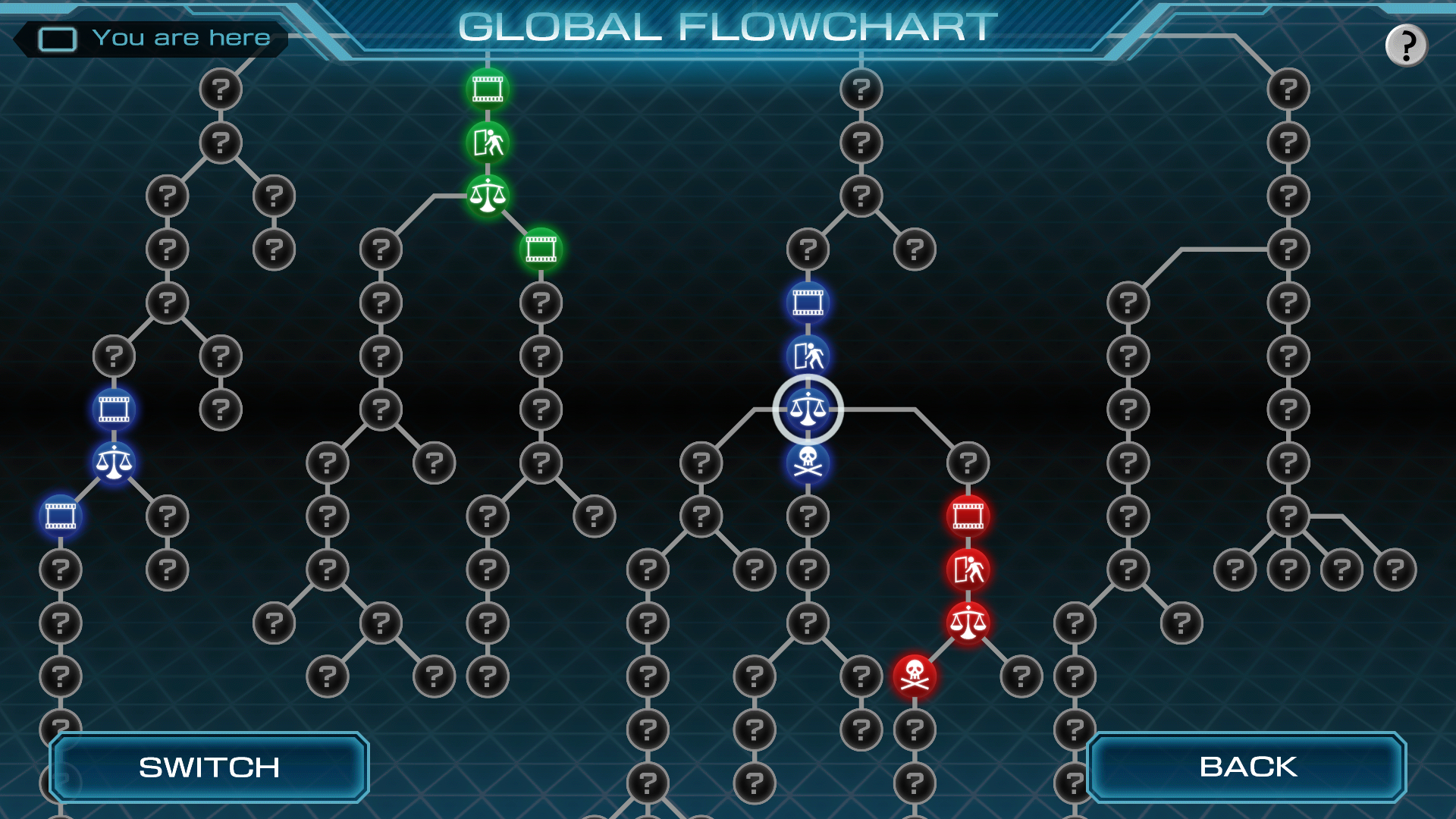
Spoilers can be deliberate
This is a screenshot of a game from the Zero Escape series. These are non-linear visual novellas where you constantly have to make choices and see how they play out. Right from the start, you can see the entire tree of possible options. The game invites you to gradually open them all. It does not hide from you that if you follow the right branch in the left chart it will lead you to a failure.
How do we do it in Pathologic? We do it in a number of ways. In some cases, we consciously use the mindmap to spoil a little bit the structure of the story development if we think this can help the player.
And sometimes, we do the opposite. If you look at this branch, you will see that the left circle is explicitly related to it. But it is not connected with a line. So what we hide here is that there is actually another circle, still invisible at this point. And if you don’t get, you will not even suspect that there is a secret ending to this story.
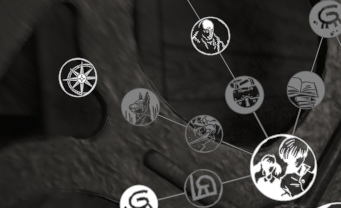
The node on the left is not connected to the storyline, so we only learn of its existence when it’s uncovered — it’s hidden; but the location still makes it clear it’s relevant to that story
Our nodes can be different colors. This is a topic for UX/UI designers, but it’s also important for us plot-wise. It so happens in our game – in any game actually that has freedom of action – that by doing one thing, you deprive yourself of the opportunity to do something else. You only choose one of the options in a dilemma – to save or to kill, to leave or to stay – and miss out on the other one.
When one of the options becomes impossible, we have to communicate it to the player. We could have just removed the corresponding node, but then there would be a hole on the mindmap and the player might feel that they simply did not find something.
So we decided to keep the nodes denoting missed opportunities on the mindmap, but we made these circles yellow and not red. We chose yellow instead of red because we didn’t want the player to feel like we were scolding them for choosing not to participate in a certain event. After all, sitting on your hands and not giving a damn is not a mistake, it’s a conscious choice.
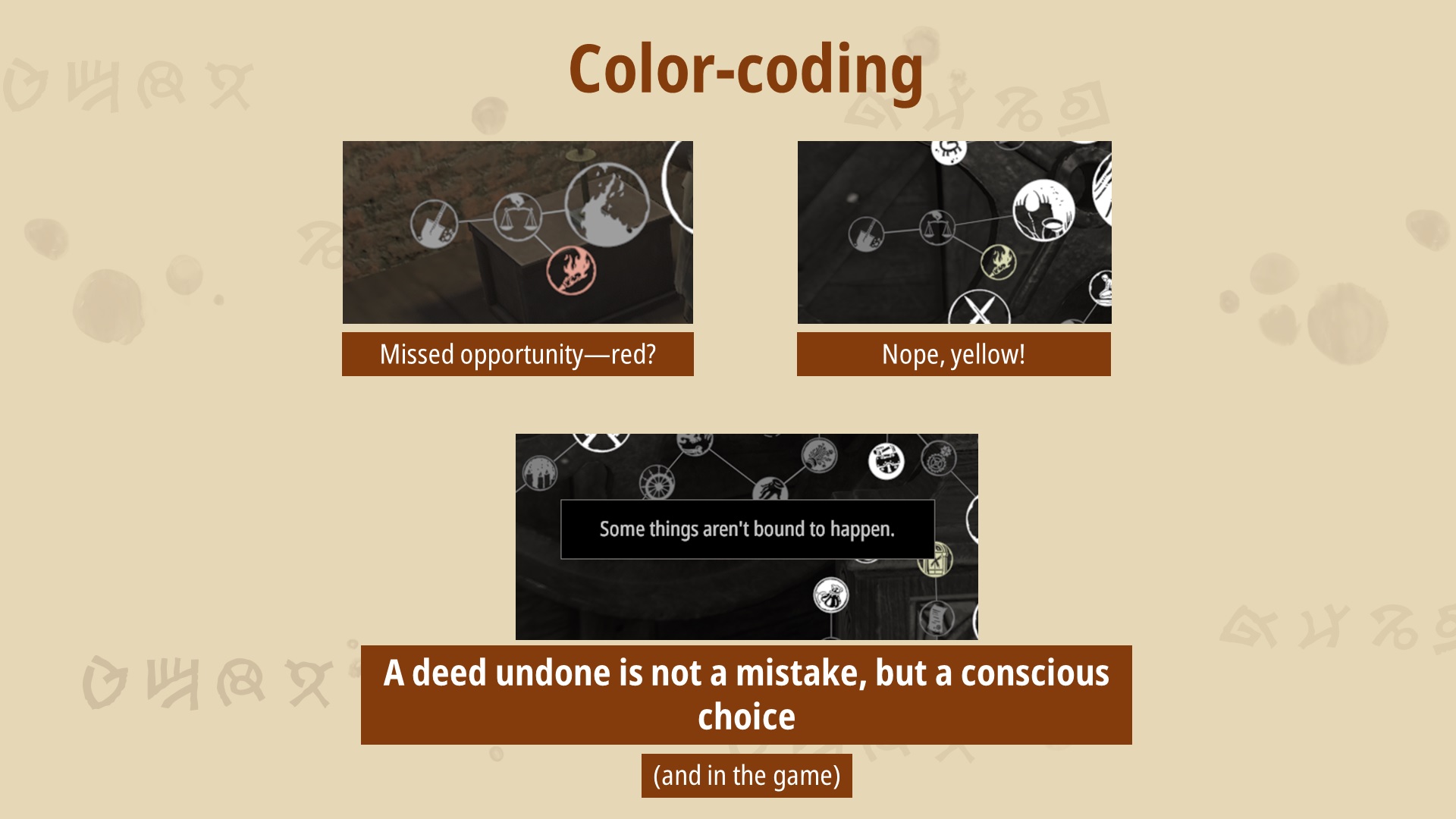
As some of you may know, Pathologic is not a remake. It’s more of re-imagining of the 2005 game. It already has an audience. And any audience that loves some kind of game, especially since 2005, especially considering how much suffering the old game caused, this kind of audience will have a very clear and expressed opinion of what they love and what they dislike. These folks can be very conservative towards any changes. Which is why I am all the more delighted to say that even the old players received the mindmap very warmly. And the overwhelming majority of our players, both old and new, said that they really liked the feature.
Why am I telling you this? As much fun as it is to just brag about how cool we are, I sincerely believe that the experience we’ve had with the mindmap can be useful to many different developers.
If you are making some kind of narrative-oriented open-world game with a complex plot, a mindmap can help you make the storyline more accessible. It will help the player to not get lost in the painstakingly written emotional dramas of several dozen characters. So all the player’s attention that would otherwise be wasted on long questlogs can be fully devoted to this pesky dialogue that took you three nights to write.
If, on the other hand, you are making something gameplay-oriented that has a very concise plot, then maybe by adding a mindmap of sorts you will make your laconic plot feel a little more interesting, a little more compelling.
Originally published on Game World Observer on August 12, 2019.
Read more about:
Featured BlogsYou May Also Like